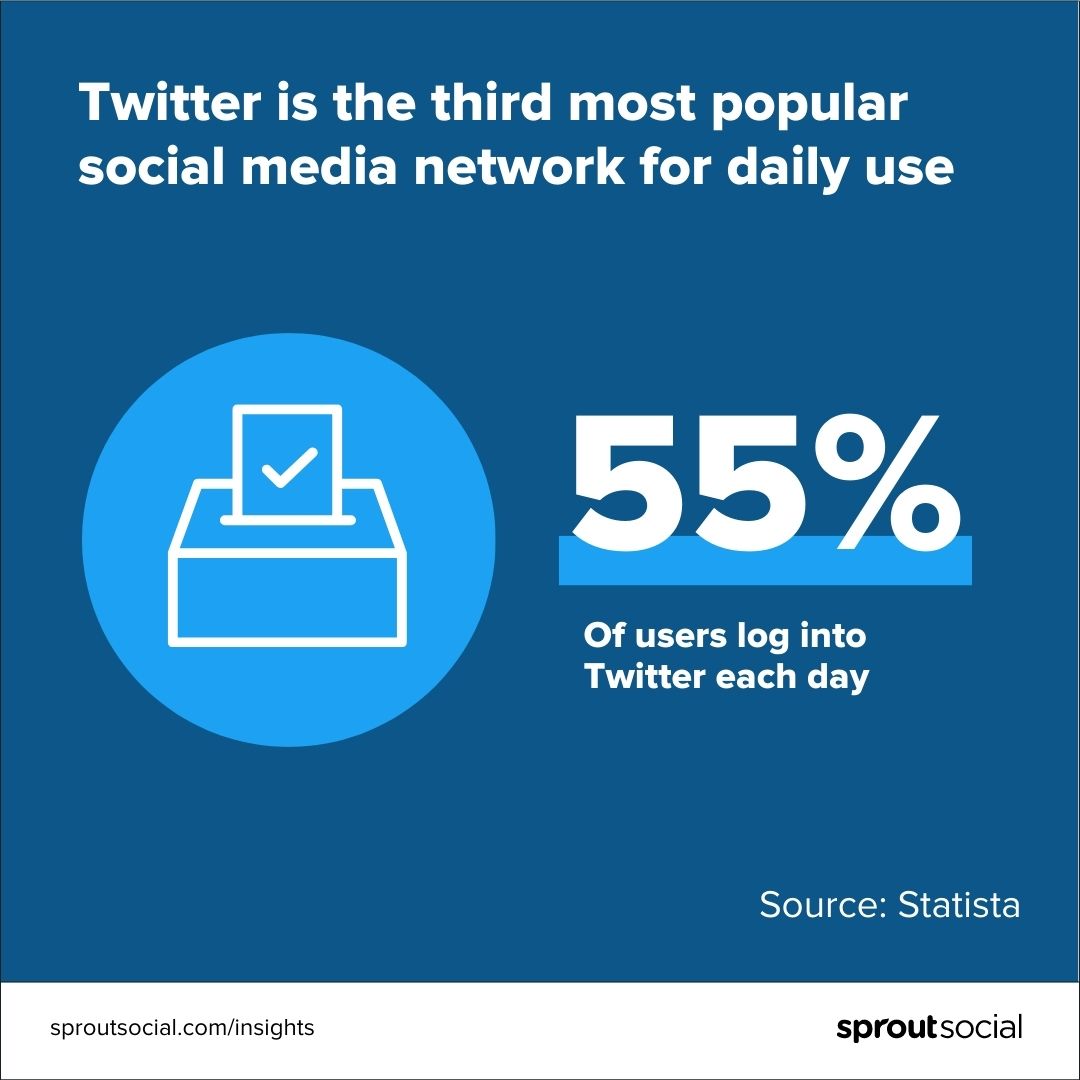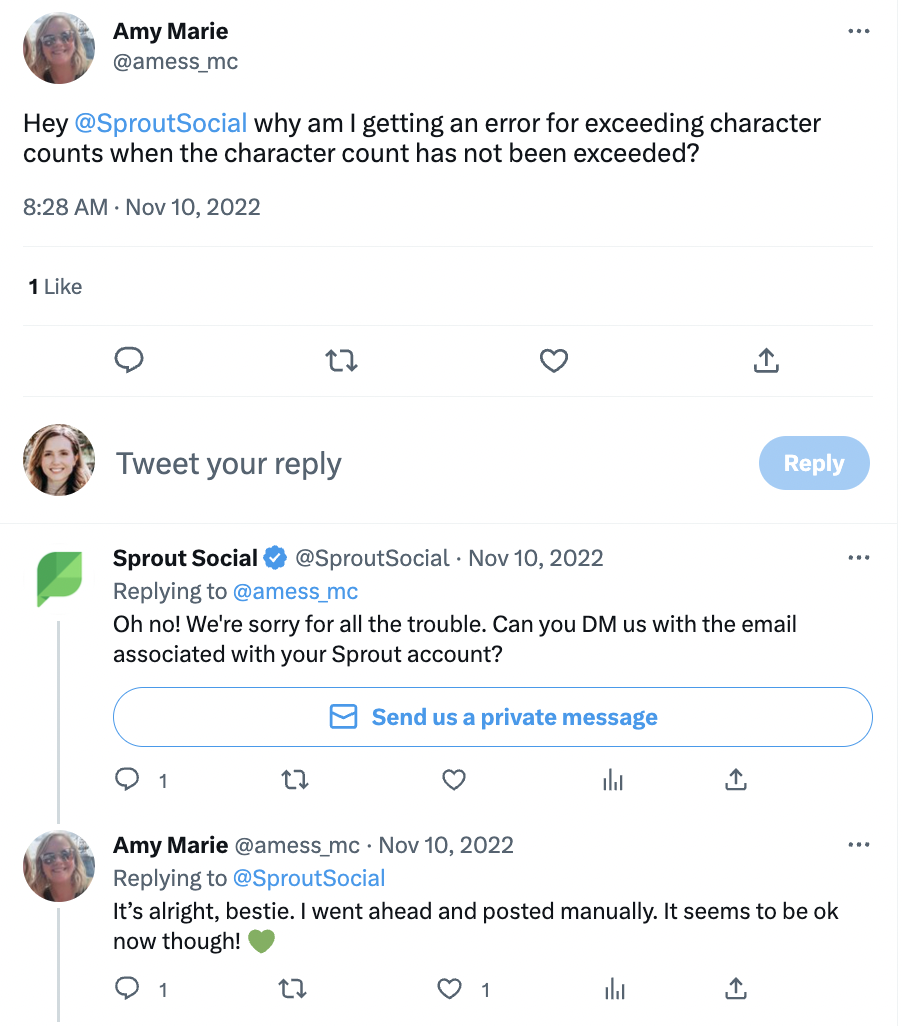23 essential Twitter statistics to guide your strategy in 2023
Written by Aubree Smith
Published on February 27, 2023
Reading time 6 minutes

Want to check the score of the game? The latest election updates? If a certain singer-turned-mogul is expecting their second child? There’s only one place to go: Twitter.
Despite a year of significant change, Twitter is still the first platform people turn to for breaking news in 2023. To tap into the hub of current events and trending conversations, you have to dig into Twitter analytics to understand how people use the platform. This includes staying up-to-date on the latest Twitter statistics that can shape your approach.
Doing so will help you better understand your target audience. According to The 2022 Sprout Social Index™, 36% of consumers will pick a brand over a competitor if they feel understood, up from 21% in 2021.

While platforms like Facebook, YouTube and Instagram might have more users, Twitter’s audience is active, engaged and plugged-in, and brands should consider it a valuable channel to connect with their audience.
Check out these 23 Twitter statistics to inspire and guide your social media strategy this year.
- General Twitter stats every marketer should know
- Twitter usage statistics that prove the platform’s impact
- Twitter user statistics to help reach your audience
- Twitter statistics for advertisers
- Twitter stats businesses need to inform their strategy
General Twitter stats every marketer should know
1. Monthly active users: 436 million
2. Worldwide usage ranking: 14th most popular social media network
3. Revenue: $5.08 billion
4. Ownership: Privately held
Twitter is at a unique crossroads. For one thing, new ownership has spurred renewed interest in the platform and increased user activity. As of January 2023, Twitter has 436 million monthly active users (MAU), up from 366 million in December 2022. Despite still trailing other networks like Facebook, YouTube, WhatsApp, Instagram and TikTok, this growth indicates rapid and notable increases in user activity. (Pro tip: Use Twitter analytics tools to measure your brand’s unique audience performance.)

On the other hand, uncertainty over the platform’s financial health looms. In its last yearly earnings report in Q4 2021, Twitter reported earning $5.08 billion in annual revenue, up 37% from the previous year. By Q2 2022, Twitter earned $1.18 billion in quarterly revenue—a decrease of 1% year over year—and reported total quarterly costs and expenses equal to $1.52 billion, according to the company’s final earnings release. No updated revenue data has been reported since Twitter was privately acquired.
But don’t count Twitter out during this time of transition. As the 14th most popular social media network in the world, it remains a major player in the social media game.
Twitter usage statistics that prove the platform’s impact
5. Monetizable daily active users: 237.8 million (55% of total users)
6. Average daily usage: 34.8 minutes/day
7. Worldwide daily engagement ranking: Third most-used social network
According to Twitter’s final earnings release, each day 237.8 million monetizable users log into the app, which is 55% of all Twitter users. On average, these users spend 34.8 minutes on the platform. For perspective, users only spend 30.1 minutes per day on Facebook, the platform consumers anticipated they would use most, according to our Index data. Twitter still trails TikTok and YouTube, but as the third most popular app for daily use, there’s no denying Twitter has the potential to help brands grow their communities by gaining new, highly-engaged followers.

Twitter user statistics to help reach your audience
8. Gender: 56.4% male, 43.6% female (Note: Sprout Social acknowledges gender isn’t binary, but our data sources limit their reporting to male and female)
9. Age: 38.5% between 25–34 years old
10. Location: US, Japan and India
11. Cross-platform usage: Instagram, LinkedIn and Facebook
12. Education level and income: One-third are college educated and make more than $75,000 annually
13. Sentiment trends: Negative sentiment toward glitches, some new features, user privacy and proposed paywall, but positive overall toward Twitter’s legacy
To maximize your chance of reaching your target audience on Twitter, you need to understand the demographic breakdown of its user base. The platform tends to sway male, with 56.4% of users identifying as such. It’s most popular with people between the ages of 25 and 34 years old, and least popular with teens. Users within this age range are also most active on Instagram, LinkedIn and Facebook.
One-third of Twitter users are college-educated and make more than $75,000 annually, highlighting the platform’s highly-educated and high-earning base. Countries leading in Twitter usage include the US, Japan and India.
Twitter’s core users loudly express their feelings about the platform. In recent months, they have raised concerns about platform glitches, new features, privacy and proposed paywalls. While sentiment has ebbed and flowed, most users are pulling for the platform to regain its wings—like this Tweet from a Twitter fan showcases.
I love Twitter's pinned lists & bookmarks feature @elonmusk pic.twitter.com/o5klGQ7PJx
— DogeDesigner (@cb_doge) February 11, 2023
Twitter statistics for advertisers
14. Annual ad revenue: $1.41 billion
15. Cost per engagement: Increased 39% from 2020 to 2021
16. Ad engagement: Decreased 12% from 2020 to 2021
17. Ad view time: 26% higher than other leading platforms
18. Industry inclusivity: Only major social platform to allow cannabis advertising
Advertising on Twitter takes multiple forms—including promoted Tweets, accounts and trending topics (as this example demonstrates). The platform strives to continuously roll out new high-impact ad types to meet evolving consumer expectations and preferences.

Despite these efforts, ROI for advertisers has significantly fallen since 2020. According to the 2021 annual earnings report, Twitter earns $1.41 billion in yearly ad revenue (up 24% year over year). Yet, ad engagement rates fell by 12% while cost per engagement increased by 39%.
In late 2022 and early 2023, Twitter’s ad revenue took a hit as major brands paused advertising efforts on the platform. Ultimately, it’s too early to tell how this will impact advertising on Twitter long term, but it does create opportunity for brands to breakthrough and experiment in the interim. Twitter reports that ad view time on the platform is 26% higher than other leading platforms.
From offering discounted ads to allowing cannabis advertising, Twitter is making attractive appeals for brands to reinvest in the platform. (If your brand sells cannabis, bookmark our article: How cannabis brands elevate their social media content.)
Twitter stats businesses need to inform their strategy
19. Best time to post: Mondays, Tuesdays, Wednesdays, Fridays and Saturdays at 9 a.m.
20. Average brand engagement rate: 0.04%
21. Discoverability: #1 platform
22. 53% of people on Twitter are more likely to be the first to buy new products
23. 15% of users and 32% of brands use Twitter for customer service
When you build your Twitter marketing strategy, it’s imperative to align your content with the style of the network. For example, Twitter is a fast-moving platform, and your Tweets will be missed if you post at the wrong time. Overall, the best times to post are Mondays, Tuesdays, Wednesdays, Fridays and Saturdays at 9 a.m., but you should find the best time to post on Twitter for your industry and audience.
The average brand engagement rate on Twitter is 0.04%. While that figure might seem low compared to other platforms, remember that Tweets often require less effort which allows brands to post more often, creating more opportunity for engagement.
Despite a low brand engagement rate, Twitter is the number one platform for discoverability, and its superpower is helping brands gain exposure to an audience eager to try something new. According to Twitter, 53% of people on the platform are more likely to be the first to buy new products.
Consumers aren’t just on the platform for Twitter ecommerce, though. According to our Index data, 15% of users and 32% of brands use Twitter for customer service and care—making it a key destination at every stage in the marketing funnel.
Use these Twitter statistics to help your brand soar
These key Twitter statistics prove the platform could still play a vital role in your brand’s social media strategy. But like all social media platforms, your brand’s performance on Twitter is what you make it. Even in the midst of Twitter’s evolution, you can find stability and success if you ground your strategy in data. Empowered with the 23 Twitter stats we shared in this article, evaluate your approach to the platform and refine your tactics to ensure you resonate with your target audience.
Start asking yourself questions like:
- Is my target audience using Twitter more or less than I anticipated?
- What does my target audience use Twitter for?
- What is my brand’s return on paid investment on the platform?
- Am I reaching my audience at the best time?
- Is my company’s Twitter customer service workflow meeting expectations?
Use your answers to guide your company’s approach to Twitter in 2023, and watch your presence take off. Keep iterating on your Twitter strategy by learning how to use Twitter effectively to grow your brand.
Recommended for you
View all Recommended for you- Categories
How to create a Twitter marketing strategy for your brand
Published on December 1, 2022 Reading time 9 minutes - Categories
Twitter for customer service: 7 pro tips and examples
Published on October 19, 2022 Reading time 7 minutes - Categories
Twitter analytics: How to analyze and improve your Twitter marketing
Published on September 15, 2022 Reading time 9 minutes - Categories
9 Twitter analytics tools to amplify your strategy
Published on August 29, 2022 Reading time 6 minutes


Share